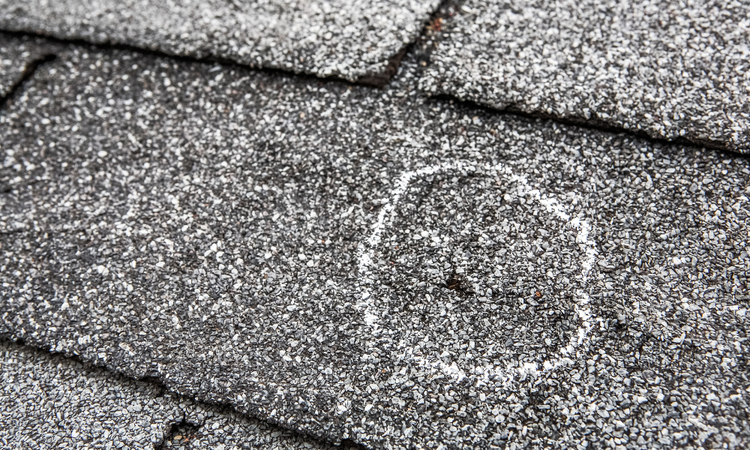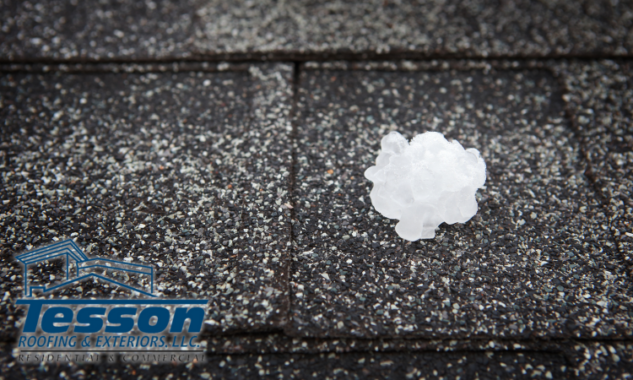Do you live in an area with lots of hail and stormy weather? You may be worried that your roof needs replacement.
The extent of hail damage that a roof can withstand before needing replacement depends on several factors, including the type of roofing material, the size and density of the hailstones, and the roof’s age and overall condition. Here are some key considerations:

- Roofing Material:
- Different roofing materials have varying levels of resilience against hail damage. Some common roofing materials and their susceptibility to hail damage include:
- Asphalt Shingles: Asphalt shingles can be vulnerable to hail damage, especially when the hailstones are large and have a high impact velocity. These shingles may show signs of cracking, dents, or granule loss.
- Metal Roofing: Metal roofing is more resistant to hail damage than asphalt shingles. It may experience dents but is less likely to develop leaks as a result of hail impact.
- Slate, Tile, or Concrete Roofs: These materials are generally more durable and less prone to hail damage. However, very large hailstones could still cause fractures or cracks in individual tiles or slates.
- Different roofing materials have varying levels of resilience against hail damage. Some common roofing materials and their susceptibility to hail damage include:
- Size and Density of Hailstones:
- The size and density of the hailstones play a significant role in determining the extent of damage. Larger and denser hailstones are more likely to cause severe damage to roofing materials. Hailstorms with smaller, less dense hailstones may result in minimal or no visible damage.
- The size and density of the hailstones play a significant role in determining the extent of damage. Larger and denser hailstones are more likely to cause severe damage to roofing materials. Hailstorms with smaller, less dense hailstones may result in minimal or no visible damage.
- Roof Age and Condition:
- The age and condition of the roof before the hailstorm can also affect its ability to withstand damage. An older roof with pre-existing issues, such as wear and tear, may be more susceptible to hail damage and may require replacement sooner.
- The age and condition of the roof before the hailstorm can also affect its ability to withstand damage. An older roof with pre-existing issues, such as wear and tear, may be more susceptible to hail damage and may require replacement sooner.
- Inspection:
- After a hailstorm, it’s crucial to have a professional roofing contractor inspect your roof for damage. Some damage, such as granule loss on asphalt shingles or small dents on metal roofing, may not be immediately visible from the ground. A thorough inspection can help assess the extent of the damage accurately.
- After a hailstorm, it’s crucial to have a professional roofing contractor inspect your roof for damage. Some damage, such as granule loss on asphalt shingles or small dents on metal roofing, may not be immediately visible from the ground. A thorough inspection can help assess the extent of the damage accurately.
- Insurance Assessment:
- If you have homeowners’ insurance, it’s advisable to contact your insurance company to assess the hail damage. Insurance adjusters can provide an expert evaluation of the damage and determine if it meets the criteria for coverage.
In many cases, minor hail damage can be repaired without the need for a full roof replacement. Roof repairs might involve replacing damaged shingles or performing spot repairs on metal roofs. However, if the damage is extensive, leading to widespread leaks, compromised structural integrity, or a compromised water barrier, a full roof replacement may be necessary.
Ultimately, the decision to replace a hail-damaged roof should be based on a professional assessment, taking into account the factors mentioned above. It’s essential to address hail damage promptly to prevent further issues such as water leaks and structural damage, which can lead to more costly repairs if left unattended. Let us help you with a FREE Estimate! Call (314) 932-1042 to get started!
